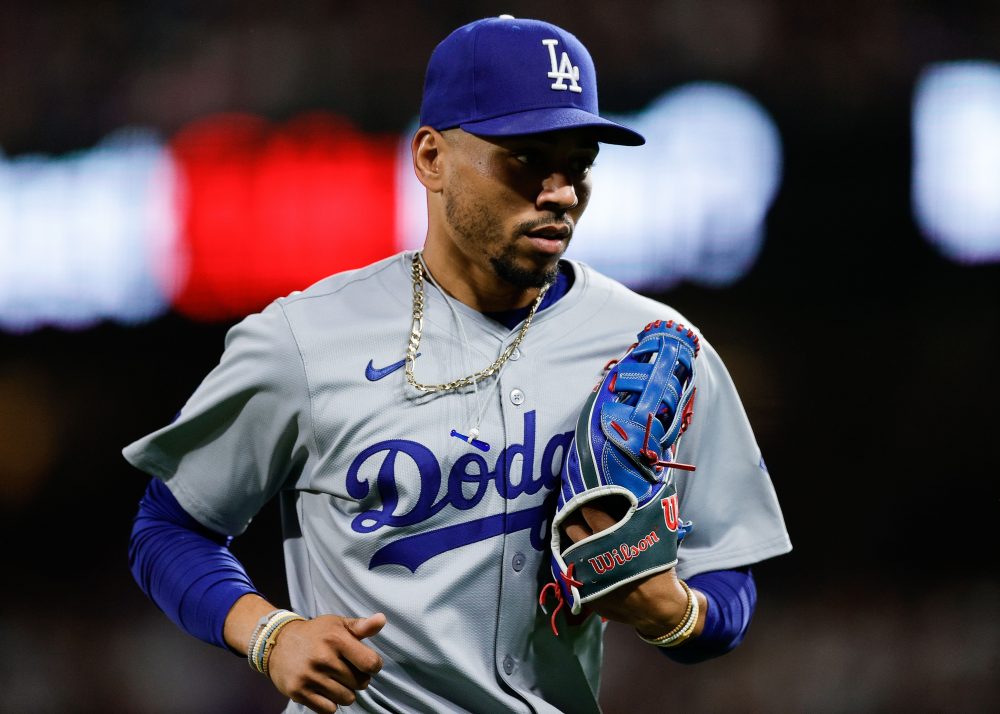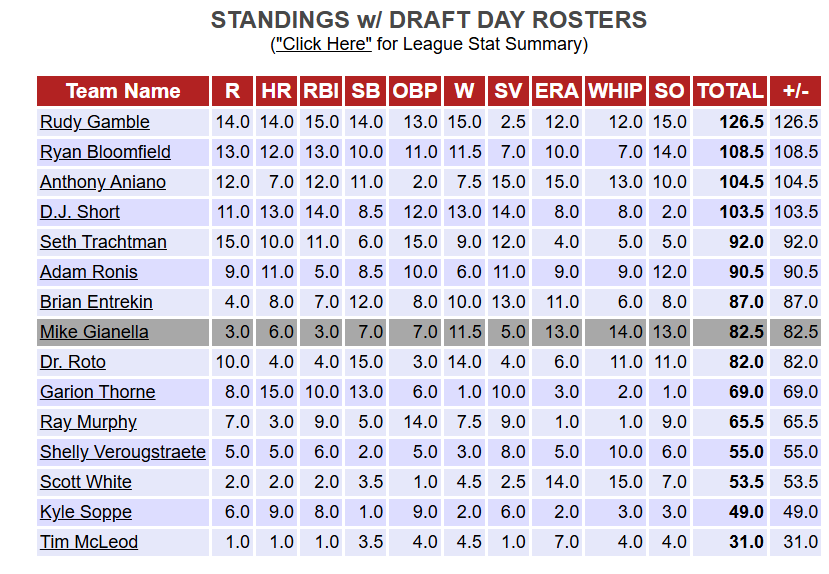
I didn’t win the Tout Wars Mixed Draft league. That honor went to Rudy Gamble of Razzball, who won his third Tout title. I mention this here so my congratulations to Rudy (an excellent fantasy player) doesn’t get buried at the bottom of this recap. I finished in a second place tie, which is very good but there was very little drama, as I finished 19 points out of first and never had a realistic chance of winning.

OnRoto – the stat service that Tout Wars uses for all its leagues – has a feature that allows you to see how everyone would have done if we just drafted our teams and made no transactions all season long. I would have finished eighth. As you can see, I did a very good job drafting pitching. Offense was another story.
Mike Gianella’s Tout Wars Roster (draft round in parenthesis)
Catchers: Salvador Perez (12), Ivan Herrera (29)
Infielders: Mookie Betts (1), CJ Abrams (4), Josh Jung (8), Nolan Gorman (11), Andrew Vaughn (13), Carlos Correa (16), Justin Turner (17), Amed Rosario (28)
Outfielders: Luis Robert (3), Josh Lowe (6), Nick Castellanos (9), Jarred Kelenic (14), Matt Wallner (19), Harrison Bader (25)
Designated Hitter: J.D. Martinez (22)
Starting Pitchers: Zack Wheeler (2), Blake Snell (5), Joe Musgrove (7), Justin Verlander (15), Shane Baz (18), Michael Wacha (21), Sean Manaea (23), J.P. Sears (24), Logan Allen (27)
Relievers: Craig Kimbrel (10), David Robertson (20), Justin Lawrence (26)
(Tout Wars uses OBP instead of AVG but otherwise is a “standard” 5×5 Roto league format)
The first thought I always have when I put these recaps together is “how did I finish as well as I did? I made a lot of mistakes! I’m a fraud!” That last sentiment isn’t true, but invariably I wind up feeling worse about the choices I made seven months ago.
Even the teams that win make suboptimal choices, so rather than completely zero in on the negative I’ll start with the positive. Even with Snell and Musgrove combining for a mere 197 1/3 innings and Verlander’s terrible season I nailed it with my pitching staff. At lot of this was Wheeler, but three of my coin flips at the back end of the draft (Baz, Wacha, and Manaea) worked out to varying degrees. One mistake both analysts and valuation calculators make is dinging incomplete seasons that come with quality ERA and WHIP. Banking those stats matters a lot. It also helps to know that Tout has unlimited IL rules, which made drafting someone like Baz easier.
Perez worked out extremely well as a 12th round pick and even in an OBP league should have been drafted earlier.
In early October everyone is lol’ing about Kimbrel – and they’re right to do it – but he finished in a 14th place tie in saves. It helped that the rest of the staff I drafted was good enough to offset his negative ERA/ WHIP, but people really misunderstood the value proposition with him all season long.
So much for the good stuff. It was a mediocre draft and a poor offensive draft.
In the days when I was new at this, I would have framed the rest of this piece as “here’s how I finished second!” In the later stages of my fantasy baseball writing non-career, I’ve recognized it’s more useful to provide you with a few takeaways of good in-season management for your own teams.
Here’s what I did that you could make work for you.
I was strategically aggressive with FAAB
This happened in two bursts, once in April when I grabbed two closers (Kirby Yates at $165 on April 15 and Hector Neris for $55 on April 22) and again in June and July to shore up my offense, getting Ben Rice for $121, Jhonensky Noel for $136 on July 1 and Tyler Fitzgerald for $128 on July 29.
Potential closers are the one place where you should be aggressive early if you have one or fewer closers and I only had Kimbrel. I had the right idea grabbing a Texas reliever in case Jose Leclerc failed but picked the wrong one at the draft. I didn’t expect to get Neris but wasn’t displeased when I did. Having three closers in tow allowed me some margin for error if one of them failed and offered me an opportunity to trade from excess later (see below).
Fitzgerald worked out amazingly well, Rice was OK for awhile (and gets graded on the curve because he’s a catcher) and Noel didn’t deliver while I had him. But you don’t need all your FAAB targets to hit, just a few. It helped immensely that I got Jurickson Profar the same week I got Yates, for $46.
An error I see other analysts make in Tout is they hoard their $1000 FAAB. The league has $0 minimum bids and because it is a mixed league there isn’t a big spending week in early August when talent from the other league is suddenly available. There are also unlimited IL slots, meaning less talent is available via FAAB. This format calls for aggressive bidding, particularly early in the season.
I traded from excess (see above)
On May 13, I traded Kimbrel for Jake Burger. This was the only trade I made all season (there were three trades in the entire league) but it was a great one. On the day of the trade, Burger had a miserable .183/.225/.317 slash line. His line the rest of the way was .263/.314/.486 with 26 home runs, 59 runs, 61 RBI, and one steal in 490 PA. It’s probably more useful to consider Burger’s seasonal pace from the moment I acquired him, which would have been 35 home runs, 80 runs, and 82 RBI. Kimbrel didn’t work out for my trading partner, Scott White of CBS Sports but that wasn’t really relevant to me since I already had Neris and Yates. Yes, I was somewhat fortunate that Burger didn’t turn into a pumpkin but the risk was worth it and it paid off.
I was patient
This was the biggest takeaway from my somewhat successful season, and something that gets lost in so much of the fantasy analysis I see out there. This is a seasonal game, not a daily or weekly one, yet most coverage is extremely fixated on which pitchers you should stream this week or if it’s time to cut Burger because he’s off to a slow start. If you are in a 10-team mixed league with very limited reserve lists this sort of approach makes sense but in the deeper leagues I compete in generally the best thing to do is be patient.
On the offensive side in leagues like this typically all you can do is wait. I was slightly lucky to get Profar (although I did correctly identify that he was a better selection that week than Edward Olivares) but a large part of that is because there weren’t many other impactful offensive free agents. Fitzgerald and Lawrence Butler were great but came much later in the season. Most of my waiting was because I had so many injured hitters to start. Some of the reason that I surged was this patience but was also due to my bad injury luck in the first half being replaced by great injury luck in the second. At one point, Correa was my only injured player, and given where I drafted him, he was already a win.
Pitching is where my patience really mattered. On June 1, I had 63 points and was in 13th place. I was 12th in ERA and last in WHIP. Musgrove was on the IL with a 5.65 ERA and the recently activated Snell had a 10.42 ERA in 19 innings. I had no idea both would eventually improve but what good would it have done me to panic and pick up volume in the hopes of getting better? Instead, I made a few low-end starting pitcher pickups but mostly chose boring middle relievers while I waited. The result was improvement in four categories (have you noticed how many wins relievers are getting these days?) and a loss of some points in strikeouts. It was worth the tradeoff.
It didn’t quite work, but there was a three-month period (from June 1 through September 1 where I was running a juggernaut out there.

Unfortunately, Tout Wars doesn’t give out a menu item for “best team within an arbitrary three-month span you cherrypicked to make yourself look good.” But this does reinforce the idea that patience is better than churning through your roster in the hopes that you can push your way into the winner’s circle. And it sure is annoying that even during my hot streak, Rudy’s team was still very good.
Thanks as always to Ron Shandler, Jeff Erickson, Peter Kreutzer, Brian Walton, and Todd Zola for all the work you do in putting together all these leagues, making sure everything goes smoothly before, during, and after the drafts, and helping to maintain the bonds that make our growing fantasy community what it is. I’ll see you many of you next year, either online or in person.
You can find a link to the Tout Wars Mixed draft league here.
Thank you for reading
This is a free article. If you enjoyed it, consider subscribing to Baseball Prospectus. Subscriptions support ongoing public baseball research and analysis in an increasingly proprietary environment.
Subscribe now